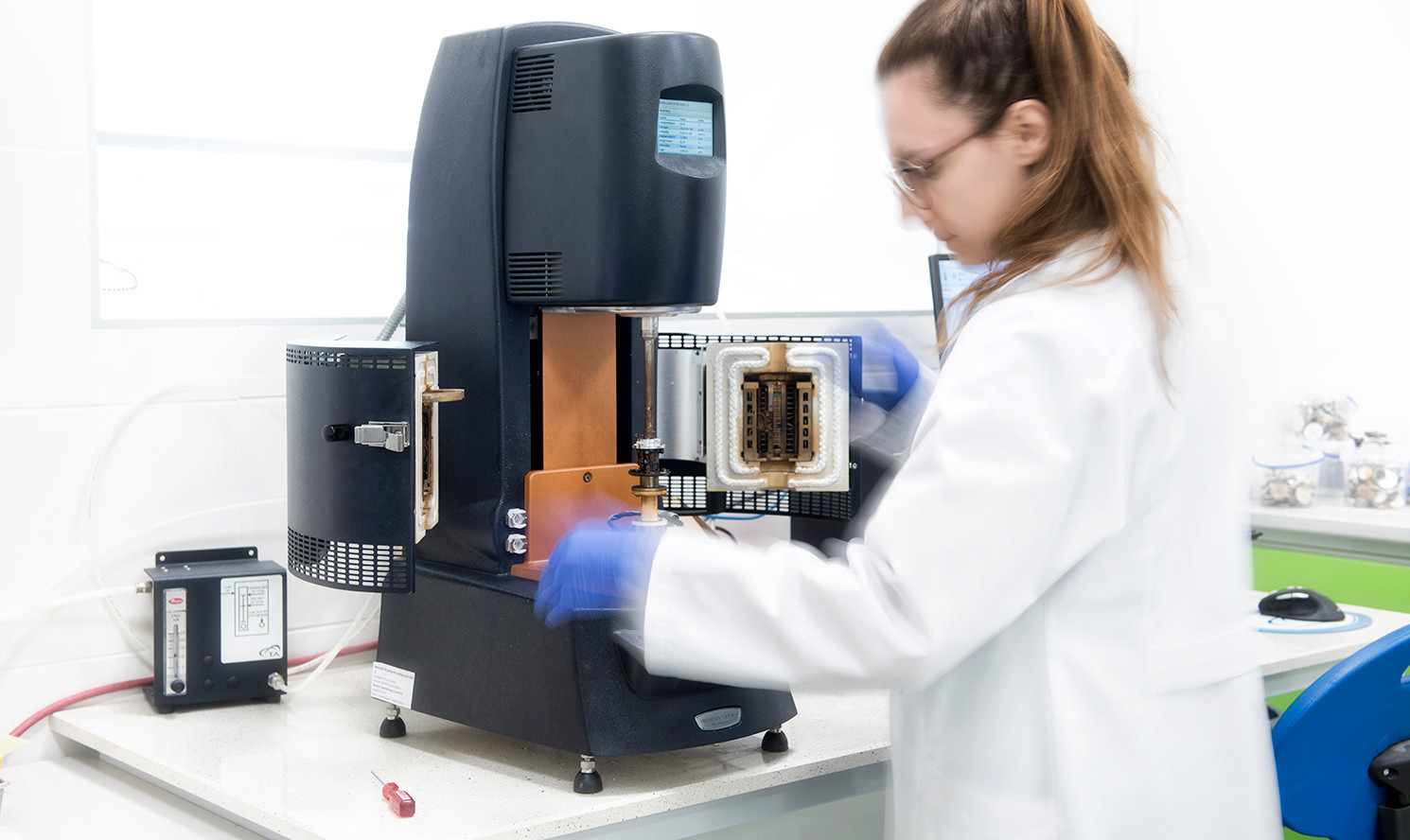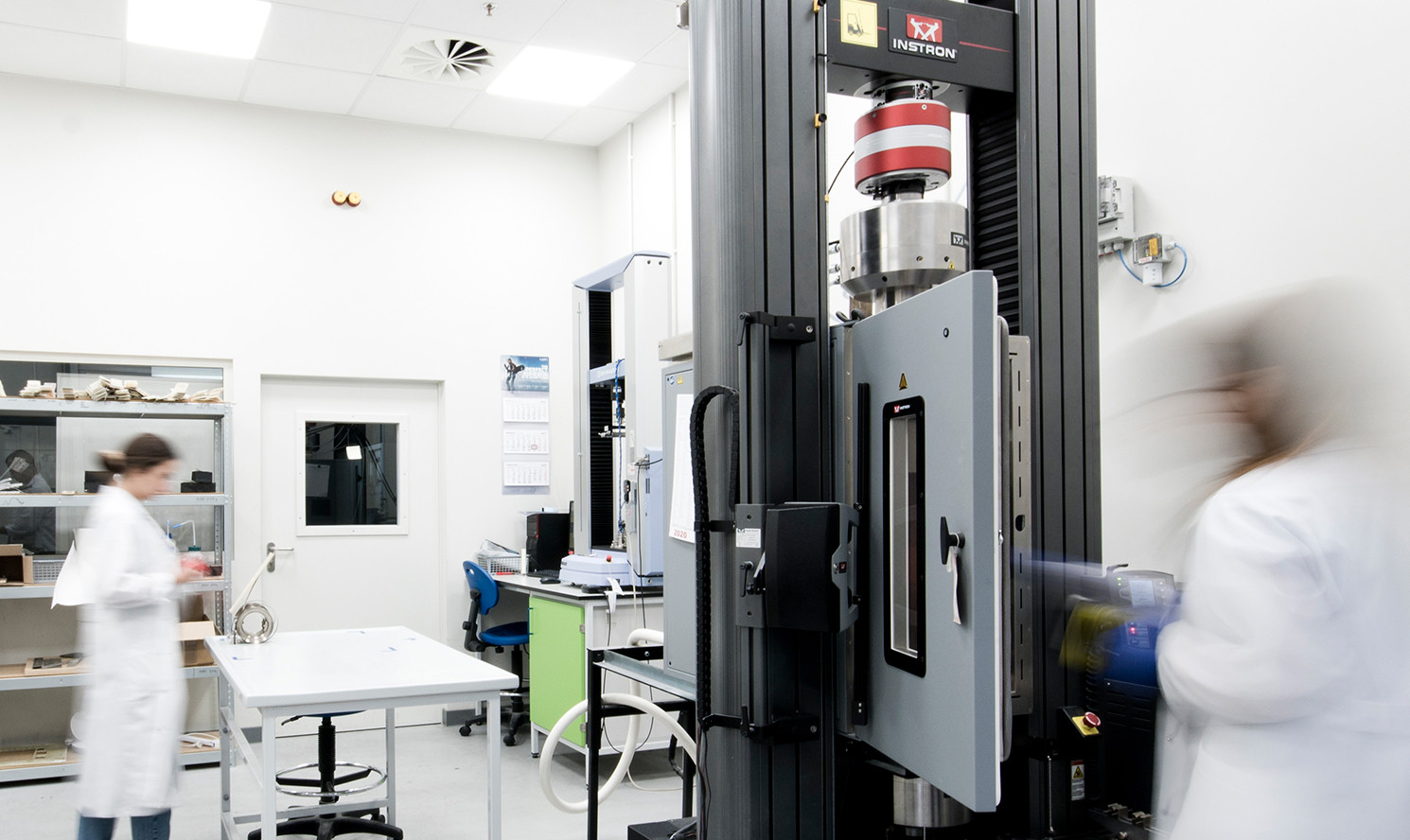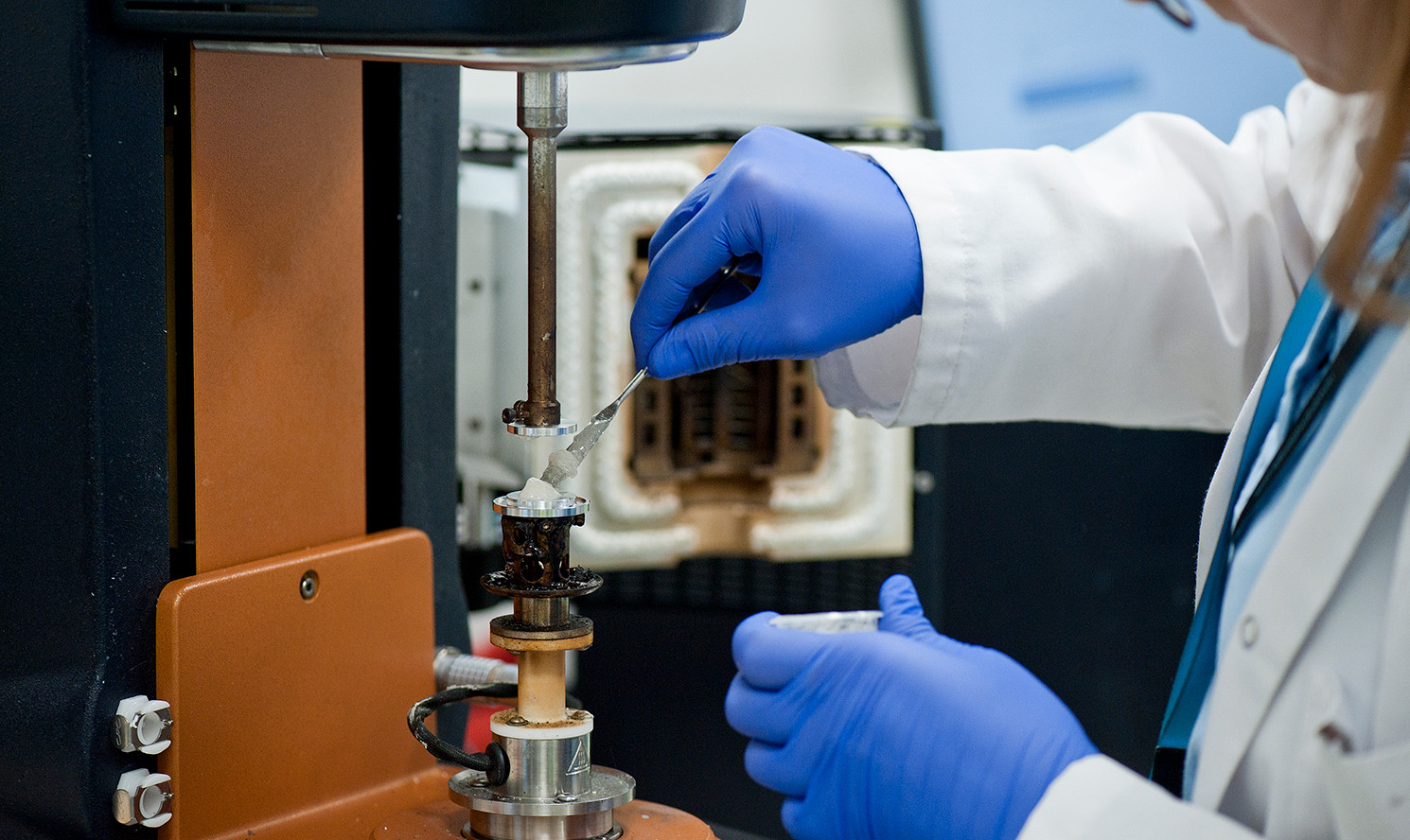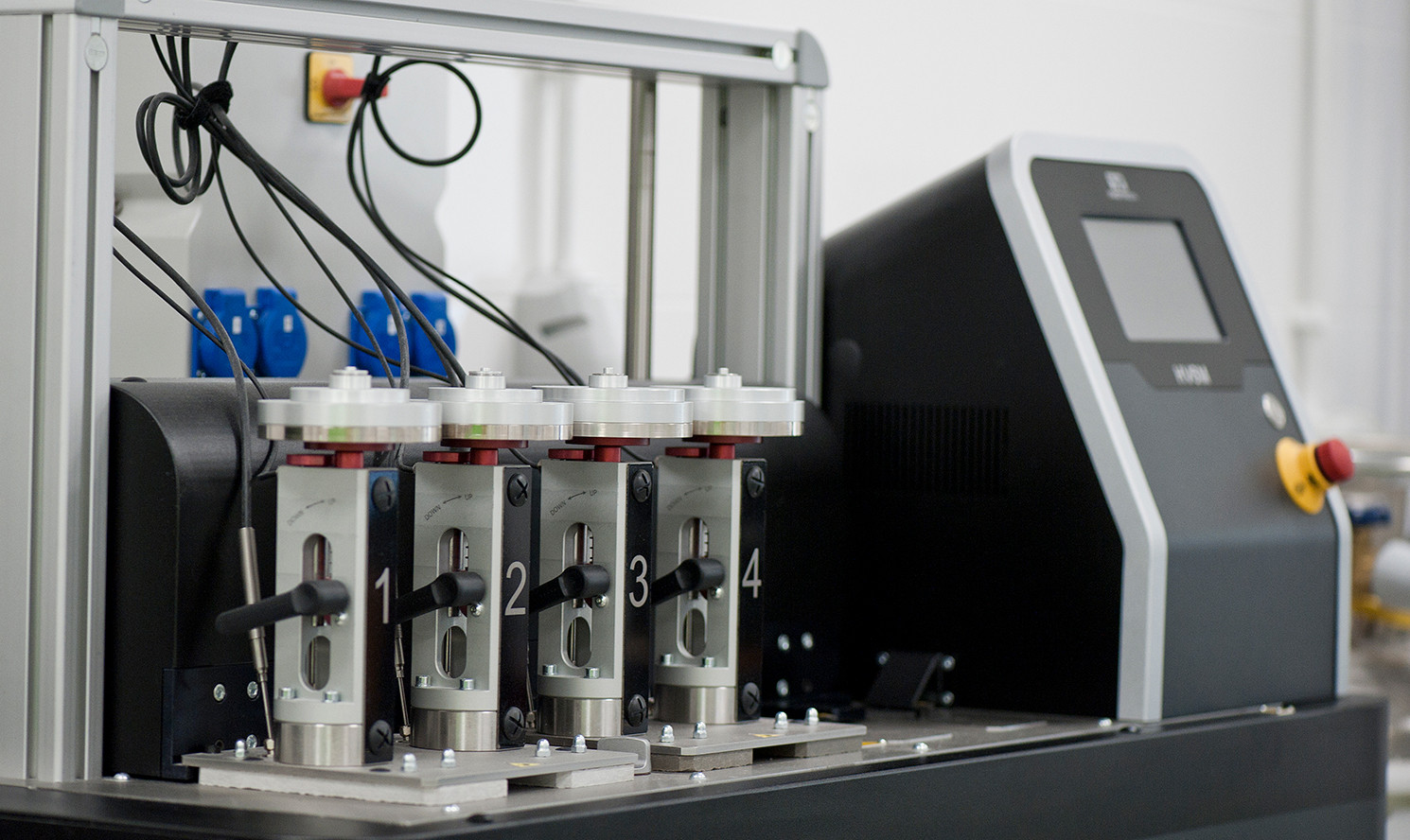
- Home
- Laboratory
“Nothing in life is to be feared, it is only to be understood” – Maria Skłodowska-Curie
New Era Materials has a modern and very well-equipped testing laboratory. We use high-end laboratory instruments to perform a wide range of analyses according to international standards.
We specialise in polymer materials and composites testing and have extensive knowledge and highly qualified personnel in this area. We can perform basic and advanced evaluation tests including the mechanical, thermal, physico-chemical as well as desired properties of the final products, i.e. flammability, adhesion, water ingress, etc.
If you would like to find out more about the expertise of our experts, please send us an enquiry.





Laboratory Facilities
Our Capacities
thermal analisys with the following equipment:
Equipment
TGA
FTIR TG 209 F1 Libra, Netzsch
DSC
DSC 204 F1 Phoenix, Netzsch
DMA
DMA 242 E/1/G Artemis, Netzsch
HDT/Vicat
CEAST HV6M, Instron
Application
- + Thermal stability of materials under loads
- + Thermal degradation of materials
- + Glass transition and melting point of polymers
- + Mechanical and viscoelastic properties of materials
- + Heat distortion temperature
- + Vicat softening point
Our Capacities
rheological analysis according to the following equipment:
Equipment
RHEOLOGY
MCR 502 TwinDrive, Anton-Paar
Discovery HR-1, TA Instruments
VISCOSITY
Application
- + Viscosity as a function of shear stress or shear rate or temperature
- + Storage and loss modulus, G’ and G”
- + Glass transition and melting point of polymers
Our Capacities
mechanical analisys with the following equipment:
Equipment
Tensile Strength
Instron 5985, 250 kN
Fatigue Resistance
Instron 8802, 100 kN
Impact Strength
Instron CEAST 9050
Adhesion
Shimadzu AGS-X
Application
- + Tensile, bending and shear properties
- + Mode I interlaminar fracture toughness GIC
- + Floating roller peel resistance of adhesives
- + Climbing drum peel test of adhesives
- + Charpy impact properties
Our Capacities
flammability analisys with the following equipment:
Equipment
LOI
OI, FTT
Smoke Density
SDC NBC, FTT
UL-94
UL-94, FTT
Application
- + Relative flammability of plastics and composite materials
- + Specific optical density of smoke generated by materials
- + Fire hazard testing by horizontal and vertical burner tests
- + Burning behavior by oxygen index
- + FTIR toxicity measurement
Equipment
Environmental simulation
Weathering simulation
Application
- + Long-term performance of the materials
- + Resistance to environmental conditions: temperature and humidity
- + Resistance to weathering condition: sunlight and rain
Equipment
FTIR
Nicolet iS10, Thermo Fisher Scientific
Epoxide equivalent
Moisture content
Sieve analysis
Analysette 3 PRO, Fritsch
Application
- + Chemical identification
- + Epoxide equivalent
- + Moisture content by Karl Fischer
- + Quantitative particle size analysis
Our Capacities
Standard
Description
ASTM D 440
ASTM D1781 – 98(2012)
ASTM D3167 – 10(2017)
ISO 11357-1:2016
Differential scanning calorimetry (DSC) –
Part 1: General principles
ISO 11357-2:2014
Differential scanning calorimetry (DSC) –
Part 2: Determination of glass transition temperature
ISO 11357-3:2013
Differential scanning calorimetry (DSC) –
Part 3: Determination of temperature and enthalpy of melting and crystallization
ISO 11358-1:2014
Thermogravimetry (TG) of Polymers –
Part 1: General Principles
ISO 14125:2001
Determination of bedning propertis
ISO 15024:2001
Determination of mode I interlaminar fracture toughness, GIC, for unidirectionally reinforced materials
ISO 16474-1:2014
Methods of exposure to laboratory light sources –
Part 1: General guidance
ISO 16474-2:2014
Methods of exposure to laboratory light sources –
Part 2: Xenon-arc lamps
ISO 16474-3:2014
Methods of exposure to laboratory light sources –
Part 3: Fluorescent UV lamps
ISO 178:2006
Determination of flexular properties
ISO 179-1:2004
Determination of Charpy impact properties-
Part 1: Non-instrumented impact test
ISO 3001:1999
Epoxy compounds-
Determination of epoxy equivalent
ISO 306:2015
Thermoplastic materials –
Determination of Vicat Softening Temperature (VST)
ISO 3219
Polymer/resins in the liquid state or as emulsions or dispersions –
Determination of viscosity using a rotational viscosimeter with defined shear rate
ISO 4589-2:2017
Part 2: Ambient-temperature test
ISO 489-1:2016
Methods of exposure to laboratory light sources –
Part 1: General guidance
ISO 489-2:2016
Methods of exposure to laboratory light sources –
Part 2: Xenon-arc lamps
ISO 489-3:2016
Methods of exposure to laboratory light sources –
Part 3: Fluorescent UV lamps
ISO 527-1:2012
Determination of tensile properties –
Part 1: General principles
ISO 527-2:2012
Determination of tensile properties –
Part 2: Test conditions for moulding and extrusion plastics
ISO 527-3:1998
Determination of tensile properties –
Part 3: Test conditions for films and sheets
ISO 527-4:2000
Determination of tensile properties –
Part 4: Test conditions for isotropic and orthotropic fibre-reinforced plastic composites
ISO 527-5:2010
Determination of tensile properties –
Part 5: Test conditions for unidirectional fibre-reinforced plastic composites
ISO 5659-2:2017
Smoke generation –
Part 2: Determination of optical density by a single-chamber test
ISO 60695-11-10:2014
Part 11-10: Test flames –
50 W horizontal and vertical flame test methods
ISO 60695-11-20:2015
Part 11-20: Test flames –
500 W flame test methods
ISO 6721-1:2006
Determination of dynamic mechanical properties –
Part 1: General principles
ISO 6721-2:2008
Determination of dynamic mechanical properties –
Part 2: Torsion-pendulum method
ISO 75-1:2005
Determination of Temperature of Deflection Under Load –
Part 3: High-Strength Thermosetting Laminates
ISO 75-1:2013
Determination of Temperature of Deflection Under Load –
Part 1: General Test Method
